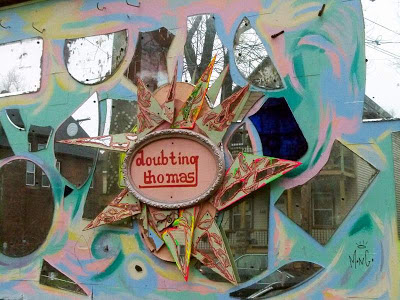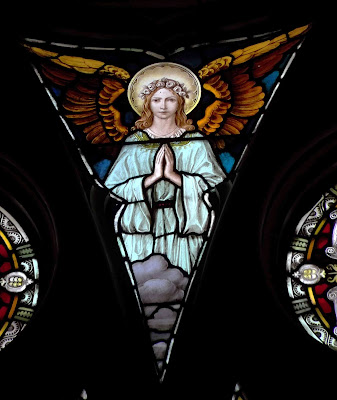August 2006. Presbyterian Church of the Covenant and a huge ribbon of shiny stainless steel
April 2012. Parking garage before the same wide undulating ribbon of roller coaster sliding
Frank Gehry designed the Peter Lewis business management building of Case Western Reserve U., near Euclid Avenue and Mayfield/Ford Road in Cleveland Ohio. Ugsome items are about campus muchly, this one is visible to the heliocopters that cruise into the neighborhood's hospitals. These distances and angles are the best aspects available. Up close and personal, not such a good idea. There is a suggestion of movement, an indication of entropy (see Second Law of thermodynamics). In physical geology there are two sorts of processes: the endogenous, and the exogenous. As these shape the terrain, the former are internally derived and cause a building up, the latter are such as gravity, erosion, weathering. So, in construction effort is exerted to build up (endogenous). These exogenous factors tend to smooth everything down. The Gehry building exhibits entropy and exogeny.
Construction was still booming in Cleveland in 1999. I spoke to a couple of people who happened to be working on the site. "Where you working at?". They called it, 'the buttons and bows building'. "What?''. "Yeah, it looks like some one dropped a giant pile of buttons and bows. Tradesmen were not to pleased working on the thing. To describe the building in familiar terms, it is a cross between the Guggenheim Museum of Modern Art in New York City, and the set of The Cabinet of Doctor Caligari.
Perhaps, for the crafts of masonry and carpentry that are outwardly visible, though adding difficulty in construction, the end result is visually interesting; but for any mechanical trade (the pipe trades, sheet metal) it is absurd. As frustrated workmen who install work linearly, and often not visually apparent in finish, must put work in continuous systems, encounter absurdities. One cannot stop a pipe in mid-air, and continue it later; a path needs to be found or created. For
some of the same reasons later, the police were not too pleased either.*
Architects with pencils are not so concerned. Well, the cost overruns on this project were considerable. Generally in construction under current American capitalism, there is much finger pointing, back biting, and no shortage of tyrannical supervision and management. Even if this was not the case here, good jobs to work on are few. It is ironic that such a building is built for graduate business administration degrees, perhaps a building of gold plated cards would be proper, where toilets would flush up.
_______________________________
*In May 2003 an insane graduate came armed and shot hundreds of rounds,
killing one person. People were hiding throughout the building, and a
mobile exchange of fire was engaged with police. Intense drama spread
for some hours. The perpetually badly wigged assailant, Biswanath
Halder, proved madder than hatter throughout his trial.


















































